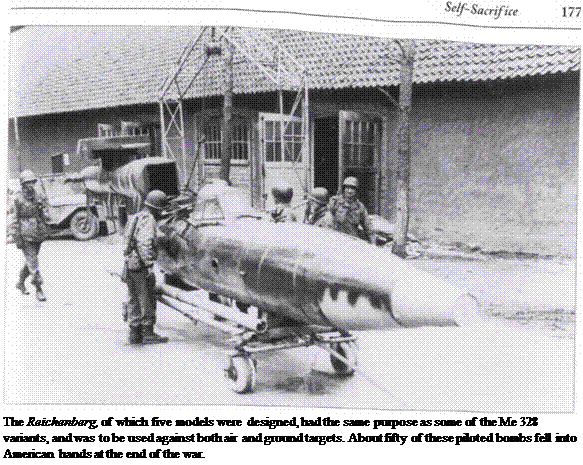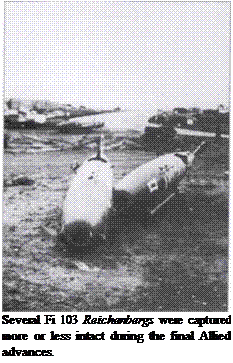Reichenberg
The suicide aircraft Reichenberg originated from a suggestion by Flugkapitan Hanna Reitsch to Hitler at the Berghof on 28 February 1944. She merely stated that the targeting characteristics of the V-l flying bomb were not good and requested permission to fly a V-l to see if the defects could not be improved. At first Hitler demurred, pointing to the more efficient jet aircraft which would soon be available to the Luftwaffe in large numbers. Suddenly, Hitler seemed to turn the matter over in his mind and surprisingly gave her his approval for a small experimental batch.
A senior aeronautical engineer at KdE, Heinz Kensche, was given the task of working on the complex problems. He decided that the development should proceed in five stages:
Re 1 single-seater, landing skid, trainer without engine.
Re 2 two-seater, landing skid, trainer without engine.
Re 3 two-seater, landing skid, trainer, with As 014 ramjet Re 4 single-seater, operational machine, with As 014 ramjet Re 5 single-seater, trainer, short fuselage, with As 014 ramjet
The plan was to give operational versions a thin-shelled SC 800 aerial mine for land objectives and a torpedo warhead for shipping targets. The development lasted from the summer of 1944 to at least March 1945, but no missions were flown with a piloted V-l. A small development team was assembled under the cover name ‘Segelflug GmbH Reichenberg. This had the cooperation of the SS and consisted of three engineers and 15 experienced supervisors and technical staff. Henschel made available a small hangar for the secret construction. Series production was scheduled at Gollnow (Goleniow) near the large Altendamm aerodrome at Stettin. The machines would be made from large sub-assemblies made at Gottartowitz/Upper Silesia (Gotarowice) and Konigsberg, with new cabin and nose components being added. The team started work at once, converting an existing V-l flying bomb to see if it could be flown manually. It had to be simple and based substantially on the standard Fi 103 to spare all unnecessary costs. Above the spartan cockpit was an Argus-Schmidt As 014 ramjet. As a rule the machine would be brought close to the target by a parent aircraft but on release could fly up to 300 kilometres under ramjet power. Once the design was completed, the drawings were forwarded to the manufacturer.
In August 1944 Henschel received a technical proposal for the development and construction of 250 prototypes with ramjet. The Commissioner for the

Reichenberg, Engineer Oberst Platz, also ordered 21 two-seater trainers. Large components supplied to Henschel were to be modified and completed with its in-house parts. The final assembly would be at Gollnow in December 1944, although presumably not on the airfield there, since this lay well to the east, and in the end Dannenberg was chosen instead.
Re 1 was to be the only version with a detachable skid. This enabled quick drainage of the fuel. Re 1 V-l was completed by the beginning of September 1944 and transported to Larz near Rechlin. The glider was carried to 4,000 metres by a Rechlin test centre He 111 and released. Pilot on this first flight was engineer Willy Fiedler, who had played a major role in the development. A second pilot, engineer Rudolf Ziegler, injured his spine when making a hard landing on uneven ground near Rechlin and had to retire from the roster. He was replaced by senior engineer Herbert Pangratz who was also seriously injured when forced to make an emergency landing after the cockpit canopy came free.
At the beginning of October 1944 the first Re 2 versions arrived at Larz. Senior engineer Heinz Kensche and Unteroffizier Schenk made the maiden

flight in the two seater Re 2 V-l. At midday on 12 October the machine was released from an He 111 H at altitude and returned safely. The next two flights from Larz took place on 13 and 19 October when Schenk partnered pilot Kachel. On further flights from Rechlin, Augstein, Meisner and Pfannenstein occupied the narrow cockpit. During the flight trials in which Hanna Reitsch was involved she crashed two Reichenbergs. It was almost impossible to escape from the aircraft, especially at high speed in gliding flight, the chances of doing so successfully being rated at 100-1.
The first and possibly only Re 3, a two-seater with As 014 ramjet propulsion, flew three times on 4 and 5 November 1944 with Heinz Kensche at the controls. The first two flights were relatively problem-free and lasted about eight minutes. On the third flight, on 5 November, the port wing began to disengage in flight forcing Kensche to bale out at 450 km/hr (280 mph). Only with the greatest difficulty did he manage to free himself from the cockpit and get past the engine. He landed in the Miiritz and swam to the bank. The cause of the defect was
heavy vibrations emitted by the ramjet which affected the fuselage. The aircraft was a write-off.
 On 28 November Kensche and Leutnant Walter Starbati flew an Re 2 twice at Larz. Starbati had previously been detached to the Zeppelin Luftschiffbau as a test pilot, and at Rechlin he appears to have received the order to test the Reichenberg personally. On 16 January 1945 Starbati flew the series-produced Re 3 (Works No. 10). After reaching speeds between 620 and 650 km/hr at 2,600 metres altitude (385—
On 28 November Kensche and Leutnant Walter Starbati flew an Re 2 twice at Larz. Starbati had previously been detached to the Zeppelin Luftschiffbau as a test pilot, and at Rechlin he appears to have received the order to test the Reichenberg personally. On 16 January 1945 Starbati flew the series-produced Re 3 (Works No. 10). After reaching speeds between 620 and 650 km/hr at 2,600 metres altitude (385—
404 mph at 8,500 ft) he detected slight reverberations in the hull although otherwise the flight attitude was no different from the Re 2. On landing, the ramjet nozzle was found to be damaged which probably accounted for the shuddering in flight. Another long circuit in an Re 3 followed on 17 February, the aircraft picking up speed at 2,000 metres. In the 17- minute flight Leutnant Starbati reached a speed of540 km/hr, repeated in a 16-minute flight the following day.
On 4,22 and 25 February Starbati also flew the Re 4 V-10, the planned operational version of the piloted V-l. After a brief period in the air the fuel system began to leak, making Starbati dizzy. He broke off the flight and ground staff found that he had lost 335 litres of the original 600 litres of fuel since he took off
At this stage the Reichenberg was useless for operations because of instability in flight and needed constant corrections to maintain course but the flight trials at Larz continued.
At the beginning of 1945 the Rechlin-Larz test centre began to consider suitable variants for pin-point attacks by suicide pilots and in the training versions. Leutnant Starbati played a major role. However, he met his fate in a short wingspan Re 3 on 5 March 1945. After reaching a speed between 400 and 500 km/hr at 2,800 metres, as he turned to port both wings detached one after the other. Under ramjet propulsion the fuselage entered a steep dive. Starbati could not open the cockpit hood and died when the machine hit the Nebelsee near Sewekow. After Unteroffizier Schenk also lost his life in a Reichenberg, the Chief-TLR noted in the War Diary on 15 March that, at the suggestion of the Rechlin test centre, OKL and the Kommodore of KG 200 had decided to terminate the project after the most recent fatal accident. Most
Reichenberg aircraft were then put into store at the Neu-Tramm Luftwaffe arsenal since there was no further use for them. On 23 April Major Fritz Hahn surrendered all 700 V-ls and the last 54 secret suicide machines to US forces which had occupied the Muna.










